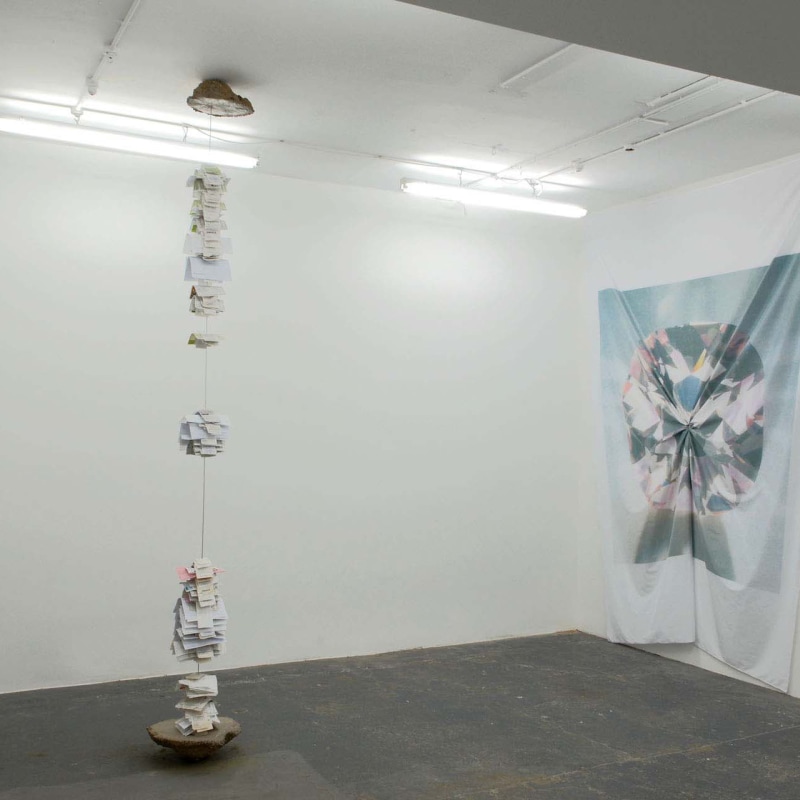For his first solo show in London and with Sadie Coles HQ, Mexican artist Gabriel Kuri presents Model for a Victory Parade. The title piece for the show comprises a simple conveyor belt with a squashed energy drink can stuck at one end, perpetually tumbling like an accidental metronome. This debris of an imagined ceremony, while holding multiple connotations, offers a material emphasis on the politics of energy consumption - a theme that runs throughout the show. Whatever the impetus for the parade, whatever the regime or prevailing power for which it stands, Kuri presents a vision of what will inevitably be left behind. If history tells us the way things were supposed to have been, then as Stephen Dubner’s and Steven Levitt’s Freakonomics proposed, “morality… represents the way people would like the world to work, whereas economics represents how it actually does work”. Drawing on this ambiguity within historical narratives, Kuri emphasises how hollow the pomp and circumstance of ceremony are when compared to its discarded remains: “believe not in the monument, believe in the drink cans littering them”.
In A Commemorative Bonfire - a bilateral work of contrasting structures in which ideas of form come to the fore - a diamond appears crumpled, its sharp geometric edges softened and collapsed. Yet the piece takes its title from the small protrusion at the front, reminiscent of a bonfire’s cone-like, wooden structure. The cut diamond is not only an emblem of consumption but also of consummation and coded experience. Assignations of value are upset and transformed as Kuri defies the impossible, manipulating the mineral’s unalterable shape, extracting another form and associative symbolism. In another piece, courtesy shampoo bottles sit on top of thick, jagged slabs of marble. At once heavy and light, soft and hard, full and empty, this piece epitomises Kuri’s gravitation towards polarities. Meanwhile, in a typically capricious gesture, Kuri creates a towering mass of receipts - one of his signature readymades. Anchored in concrete and running floor-to-ceiling, this piece is bound by what Mercedes Vicente has described as Kuri’s “irrefutable and inexorable logic”.
In his sculptures, collages, installations, and photographs, Kuri distils his observations of the everyday into the realm of formal aesthetics with powerful results. His recurrent choice of objects (receipts, plastic bags, stones) and themes (consumerism, economics, temporality) have, over time, built into a strong visual vocabulary, which while instantly identifiable, is carefully reworded in accordance with each context. Absorbed by questions of production, Kuri confidently navigates the areas between the found object, process and the built or manufactured. Often playful, he uncovers and shares surprises he finds, as in Untitled Fridge Trinity (2004) in which plastic bags hover ghost-like in fridges mid-air. He is a unique accountant, as witnessed in his wall-hung tapestries of receipts that he has produced since 2001, which arguably veer towards Minimialism in their concern for seriality and repetition. And he quickly invokes the unwitting passerby to collaborate, notably as part of Items in Care of Items in the 5 Berlin Biennial comprising of huge yellow-painted, steel constructions that constituted the Neue Nationalgalerie’s cloakroom, in and on which people left coats, bags and even babies.
Gabriel Kuri, born in 1970, lives and works in Brussels and Mexico City. He studied at the Escuela National de Artes Plasticas, Mexico (1988-92) and Goldsmiths College, London (1993-95). Solo exhibitions include: and thanks in advance, Govett-Brewster, New Plymouth, New Zealand, 2006; Start To Stop Stopping, MUHKA, Antwerp, Belgium, 2003; and Museo de las Artes de Guadalajara, 1999. Groups shows include: 5 Berlin Biennale, Berlin, Germany, 2008; Unmonumental: The Object In The 21st Century, New Museum of Contemporary Art, New York (NY), USA and the 50th International Art Exhibition Venice Biennale / Biennale di Venezia, La Biennale di Venezia, Venice, Italy, 2007. He has been the subject of a number of publications including: SUGGESTED TAXATION SCHEME, Roma Publications, 2007; and thanks in advance, A & R Press/Turner, 2007; and Compost Index, Roma Publications, 2005.
For further information please contact the gallery at +44 (0)20 7493 8611 or press@sadiecoles.com
